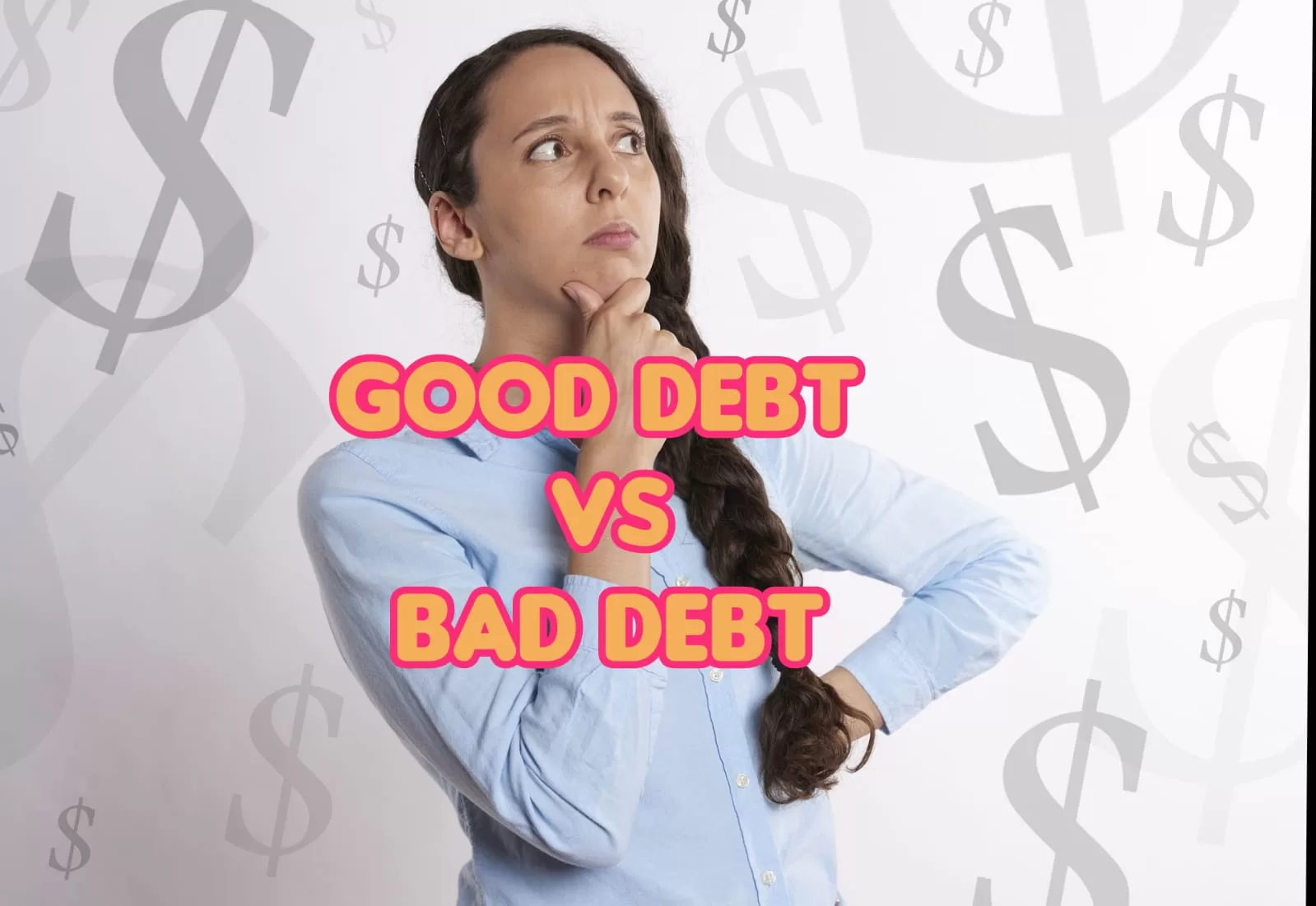Debt can be a scary word for many people, but not all debt is created equal. In fact, some forms of debt can actually be beneficial to your financial situation. However, it’s important to distinguish between good and bad debt in order to make smart financial decisions.
So what exactly is the difference between the two? And how do you know which type of debt you’re taking on? In this blog post, we’ll explore the world of good vs bad debt and provide tips on how to tell them apart so that you can take control of your finances and build a solid financial future.
Introduction: What is Good Debt vs Bad Debt?
In order to make informed decisions about your finances, it’s important to understand the difference between good debt and bad debt. Good debt is typically defined as debt that is used to purchase something that will appreciate in value or generate income. Examples of good debt include investment properties, education loans, and business loans. Bad debt, on the other hand, is defined as debt that is used to purchase something that will depreciate in value or does not generate income. Credit card debt and personal loans are typically considered to be bad debt.
When you’re trying to determine whether a particular type of debt is good or bad, there are a few key factors to consider.
First, you need to look at the interest rate on the loan. Debt with a high interest rate is generally considered to be bad debt because it will cost you more money in the long run.
You also need to consider the purpose of the loan. As mentioned above, loans used for investments or education are typically considered good debts because they can generate income or appreciate in value over time. Loans used for consumption purposes, such as buying a new car or taking a vacation, are generally considered bad debts because they do not generate any additional value.
Finally, you need to think about your ability to repay the loan. If you are confident that you will be able to repay the loan without any problems, then it is probably a good debt. However, if you are struggling to make your monthly payments, then it is likely a bad debt and you should consider ways to reduce or eliminate it.
Types of Good Debt and Examples
Good debt is generally considered to be a type of debt that is taken on to finance investments that can potentially increase in value or generate income over time. Here are some examples of good debt:
Student Loans:
If you take out a loan to fund your education, it can be considered good debt. Education can increase your earning potential over time and lead to better job opportunities, which can make it easier for you to pay back your loan.
Mortgages:
A mortgage can be considered good debt if you use it to buy a home. Homeownership is generally considered a good investment, as it can increase in value over time and provide stability and security.
Small Business Loans:
If you take out a loan to start or expand a small business, it can be considered good debt. If your business is successful, it can generate income and potentially increase in value over time.
Investment Loans:
If you take out a loan to invest in the stock market or real estate, it can be considered good debt if your investments generate a higher return than the interest rate on the loan.
It’s important to note that even “good” debt can become “bad” debt if you are unable to make your payments or if your investments don’t perform as expected. It’s always important to carefully consider the risks and benefits before taking on any debt.
Types of Bad Debt and Examples
There are two main types of bad debt: unsecured and secured.
Unsecured debt is not backed by any asset, so if you can’t pay it back, the lender can’t take anything from you. Credit cards are the most common type of unsecured debt.
Secured debt is backed by an asset, such as your home or car. If you can’t pay back a secured loan, the lender can repossess your asset.
Some common examples of bad debt include:
Bad debt refers to debt that is taken on for purchases that do not generate long-term value or do not appreciate in value over time. Here are some examples of bad debt:
Credit Card Debt:
Credit card debt is considered bad debt because it often carries high interest rates and is usually used to finance discretionary purchases that do not generate long-term value, such as vacations or luxury items.
Personal Loans for Non-Essential Expenses:
Personal loans used to finance non-essential expenses, such as a new wardrobe, an expensive vacation, or a new gadget, are also considered bad debt. These types of purchases do not generate long-term value and can lead to a cycle of debt.
Car Loans:
While a car loan can be considered good debt if it is used to purchase a reliable car that is necessary for work or transportation, it can become bad debt if you purchase a car that is too expensive or not necessary.
Payday Loans:
Payday loans are considered bad debt because they often carry extremely high interest rates and are used to cover short-term expenses, such as rent or bills. They can lead to a cycle of debt and financial instability.
Student loans:
Student loans usually have low interest rates, but they can still be difficult to repay if you don’t have a good job after graduation. Defaulting on student loans can damage your credit score and make it difficult to get a car loan or mortgage in the future.
Medical bills:
Medical bills are one of the most common types of bad debt. Many people are unable to pay their medical bills due to an illness or injury, and they can quickly accumulate into large amounts of debt.
It’s important to note that any type of debt can become bad debt if you are unable to make your payments or if you take on too much debt relative to your income and financial resources. It’s always important to carefully consider the risks and benefits before taking on any debt.
The Different Factors to Consider When Deciding Between Good and Bad Debt
When considering whether debt is good or bad, there are several factors to take into account. Here are some of the most important ones:
Interest rates: Good debt typically has a lower interest rate than bad debt. For example, a mortgage or student loan often have lower interest rates compared to credit card debt or personal loans.
Purpose of the debt: Good debt is typically taken on for investments that have the potential to increase in value or provide a long-term benefit. For example, a mortgage can help you buy a home that can increase in value over time. Student loans can help you earn a degree that can increase your earning potential. In contrast, bad debt is usually taken on for purchases that don’t provide long-term value or that lose value over time, such as credit card debt for discretionary spending.
Repayment terms: Good debt often has longer repayment terms, giving you more time to pay it off at a reasonable rate. For example, mortgages and student loans typically have repayment terms of 15-30 years. In contrast, bad debt often has shorter repayment terms and higher monthly payments, such as credit card debt with high interest rates and penalties for late payments.
Your ability to repay: Even if the debt is for a good purpose and has favorable terms, it’s important to consider your ability to repay it. Taking on too much debt can lead to financial stress and damage your credit score. You should only take on debt that you can realistically afford to repay.
Your overall financial situation: It’s important to consider your overall financial situation when deciding whether debt is good or bad. If you have a stable income, low debt-to-income ratio, and a good credit score, taking on good debt can help you build wealth over time. But if you’re already struggling with debt, taking on more debt, even if it’s for a good purpose, could make your financial situation worse.
Overall, good debt is debt that is taken on for a purpose that can help improve your financial situation over time, has favorable terms, and is affordable to repay. Bad debt is debt that doesn’t provide long-term value and has unfavorable terms that make it difficult to repay.
How to Manage Your Debt Effectively
There are a few key things to keep in mind when trying to manage debt effectively. The first is knowing the difference between good debt and bad debt. Good debt is generally considered to be investments that will grow in value over time, such as a mortgage or student loan. Bad debt, on the other hand, is money that’s been borrowed for something that will depreciate quickly, like a car or credit card purchase.
Once you’ve identified which debts are good and which are bad, you can start working on a plan to pay them off. For bad debts, the goal should be to pay them off as quickly as possible to avoid accruing more interest. For good debts, you’ll want to create a budget and make sure you’re making your payments on time each month. You may also want to consider refinancing your good debt if you can get a lower interest rate.
The most important thing when it comes to managing your debt effectively is to create a plan and stick to it. By doing so, you’ll be well on your way to financial freedom.
Conclusion
The difference between good debt and bad debt is not always easy to discern, but it is essential to understand the distinction. With knowledge of the differences between them, you can make smarter decisions about which debts are worth taking on and which ones should be avoided. By following these tips, you can ensure that your finances remain in a healthy state for years to come.
FAQ
Debt is money borrowed that needs to be paid back with interest, while good debt is a type of debt that is taken on with the intention of improving one’s financial situation over the long term, such as student loans or mortgages.
No, not all debt is bad. Debt can be a useful financial tool if used responsibly and strategically. Good debt, such as student loans or mortgages, can help improve your financial situation over time.
Some examples of good debt include student loans, mortgages, or business loans. These types of debt can help you invest in your future and improve your financial situation over time.

